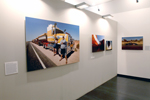Australia,
sulle tracce di Chatwin venti anni dopo Le Vie dei Canti
Palazzo Ducale, Genova
Australia, on Chatwin's footsteps twenty years
after The Songlines
Palazzo Ducale, Genoa


Viaggiando
in Australia è inevitabile, tranne se si resta solo nelle grandi
città, avere un incontro ravvicinato con uno strano tipo di bestie.
Possono arrivare anche a 70 metri, pesare 15 tonnellate, andare oltre
i 100 chilometri all’ora, avere fino a 60 ruote. Sono i road train,
autotreni formati da una motrice e tre o quattro rimorchi, perché
per le grandi distanze da coprire conviene tirarsi dietro quanto più
possibile - di bestiame, cibo, auto - tanto la strada è quasi sempre
dritta, le curve dolci, si fa manovra solo per caricare e scaricare o
alla stazione di servizio. Anche a Chatwin capita: «I road-train
avevano tre rimorchi: sbucavano di continuo dal tremolio del calore e
invadevano il centro della strada senza rallentare». Trovarseli
di fronte o starci dietro può essere problematico. Per sorpassarli
bisogna calcolare tempo e distanza adeguati alla loro taglia, senza contare
la polvere che si alza e lo spostamento d’aria da compensare. Poi
ti abitui. Saluti gli autisti, come fanno loro, sollevando appena l’indice
della mano sul volante. Li incroci nelle aree di parcheggio o nelle roadhouse
lungo la strada. Bistecca, birra e riposo nella nicchia ricavata nella
cabina sopra il posto di guida. Poi via nella notte o all’alba,
per combattere il caldo. Peter e Ben, 32 e 28 anni, sono amici e, se riescono,
viaggiano assieme. Lungo la Lasseter Highway, che collega Uluru alla Stuart,
si sgranchiscono le gambe dopo una tratta di 500 chilometri. Soste e ripartenze.
È dura, ma varia. Vengono dal Queensland e scendono verso il South
Australia. Seimila chilometri in sette giorni. L’Italia? Bel posto,
un giorno magari. È lontana, quanto? Dodici, quattordicimila chilometri
in linea d’aria. Non tanto, ridono, mentre calcolano che con il
loro road train ci metterebbero due settimane